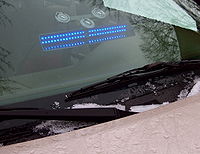- Courtesy lights
-
Courtesy Lights are used by volunteer firefighters and emergency medical technicians (EMTs) to expedite their drive, in their privately owned vehicles, to their firehouse or EMS Base. Courtesy lights are also used by tow-trucks, snow-plows and other hazard vehicles, as well as some construction vehicles, rural mail delivery vehicles and school buses.[1]
Laws
A vehicle lawfully displaying courtesy lights is not an emergency response vehicle. In some states, there are no laws that permit vehicles with courtesy lights to break traffic laws, hence the name courtesy lights. A vehicle with courtesy lights must still stop at stop signs, red lights, etc. and may not speed or disobey any traffic regulations.[1] Usually, violation ticket fines are increased if the ticketed car was flashing courtesy lights. Laws vary greatly by state.[citation needed]
Some states, such as Kentucky, give personal vehicles used by firefighters, EMTs, and rescue squad members the same privileges as emergency vehicles,[2] and may break traditional traffic laws such as speed while en route to an emergency.[3] In New York, as a courtesy, it is civil and neighborly, but not always required by law, to let a vehicle displaying blue or green courtesy lights pass, if it is safe to do so.[1] In New Jersey it is required by law for drivers to yield to vehicles displaying a blue light or red light.[4] In Maine, TITLE 29-A, Subsection 2054 states, Firefighters, EMT's, and Paramedics per Chief or Director of there respective department can authorize the use of red or combination red and white auxiliary lights above the front registration plate and below the roof of the POV en route and at the scene of an emergency. All Maine state traffic laws and regulations apply.
A vehicle displaying amber lights is not responding to an emergency, and right-of-way need not be yielded, as it may create an unnecessary dangerous situation.
A permit is required to display a courtesy light.
Colors
Different vehicles use different colored lights:[1][5][6]
- Volunteer Firefighters use blue and/or white courtesy lights (see picture), though some states designate red emergency lights for volunteer/call firefighters.
- Volunteer EMTs use green courtesy lights, but some states will allow volunteer EMTs to use a blue or red courtesy light.
- Tow-trucks and other vehicles, including construction vehicles, use amber courtesy lights.
Potential Danger
If not used in accordance with vehicle and traffic laws, courtesy lights may present a great danger to volunteer firefighters and EMTs, who use the lights to exceed the speed limit or pass other vehicles. The largest category (30%) of fatal crashes for volunteer firefighters (from 1994–2004) involved personal vehicles. Of those crashed, 80% occurred en route to the firehouse for an alarm.[7] Some firefighters, usually department veterans, choose not to display courtesy lights, claiming that they do not even significantly decrease response time.[citation needed]
For vehicles with amber lights, courtesy lights generally create a safer situation. This is because the primary function of an amber light is to increase visibility, not expedite travel. Still, vehicles involved with accidents that display amber lights are not heeded as much as their red- or blue-light displaying counterparts, which makes a crash scene more dangerous for a tow-truck operator than a firefighter or EMT.[8]
New Jersey Blue Light Laws
In New Jersey, a privately owned vehicle (POV) is only allowed to display a blue light with a permit. The approval of the permit is based on the status of the individual. EMTs and firefighters display blue lights. While officers of Emergency Medical Service squads and fire departments are allowed to display red lights. Vehicles with courtesy lights in New Jersey are not permitted to break traffic laws. However, it is required by law for vehicles to yield to vehicles using blue(red) lights. Hide-a-way and headlight flashers (commonly known as wig-wags) are not allowed on a POV in New Jersey.
References
- ^ a b c d "Driver's Manual and Study Guide". http://www.nydmv.state.ny.us/dmanual/default.html. Retrieved 2009-06-22.
- ^ "189.910 Definitions for KRS 189.920 to 189.950.". http://lrc.ky.gov/krs/189-00/910.pdf. Retrieved 2009-06-22.
- ^ "189.940 Exemptions from traffic regulations.". http://lrc.ky.gov/krs/189-00/940.pdf. Retrieved 2009-06-22.
- ^ "Stopping Regulations". http://www.nj.gov/mvc/manuals/chap_04_13.html. Retrieved 2009-06-22.
- ^ "189.920 Flashing Lights" (PDF). http://lrc.ky.gov/krs/189-00/920.pdf. Retrieved 2009-06-22.
- ^ "(625 ILCS 5/) Illinois Vehicle Code". http://www.ilga.gov/legislation/ilcs/ilcs4.asp?DocName=062500050HCh%2E+12+Art%2E+II&ActID=1815&ChapAct=625%26nbsp%3BILCS%26nbsp%3B5%2F&ChapterID=49&ChapterName=VEHICLES&SectionID=59744&SeqStart=121100000&SeqEnd=122900000&ActName=Illinois+Vehicle+Code%2E. Retrieved 2009-06-22.
- ^ "Fatalities Among Volunteer and Career Firefighters -- United States, 1994-2004". http://www.cdc.gov/mmwr/preview/mmwrhtml/mm5516a3.htm. Retrieved 2009-06-22.
- ^ Bencks, Jarret (August 5, 2008). "Blue, red and amber lights mean slow down and move over Law changes in effect today.". The Eagle Tribune. http://www.eagletribune.com/punewsnh/local_story_218030043.html. Retrieved 2009-06-22.
See also
Categories:- Emergency vehicles
Wikimedia Foundation. 2010.

